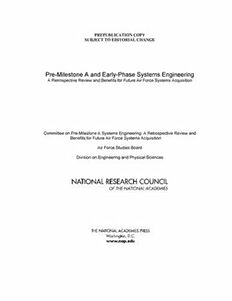
Pre-Milestone A and Early-Phase Systems Engineering: A Retrospective Review and Benefits for Future Air Force Acquisition PDF
151 Pages·2008·1.205 MB·English
Most books are stored in the elastic cloud where traffic is expensive. For this reason, we have a limit on daily download.
Preview Pre-Milestone A and Early-Phase Systems Engineering: A Retrospective Review and Benefits for Future Air Force Acquisition
Description:
The ability of U.S. military forces to field new weapons systems quickly and to contain their cost growth has declined significantly over the past few decades. There are many causes including increased complexity, funding instability, bureaucracy, and more diverse user demands, but a view that is gaining more acceptance is that better systems engineering (SE) could help shorten development time. To investigate this assertion in more detail, the US Air Force asked the NRC to examine the role that SE can play during the acquisition life cycle to address root causes of program failure, especially during pre-milestone A and early program phases. This book presents an assessment of the relationship between SE and program outcome; an examination of the SE workforce; and an analysis of SE functions and guidelines. The latter includes a definition of the minimum set of SE processes that need to be accounted for during project development.
See more
The list of books you might like
Most books are stored in the elastic cloud where traffic is expensive. For this reason, we have a limit on daily download.
